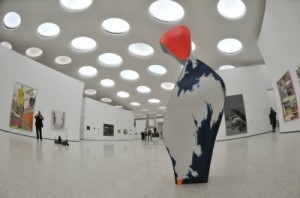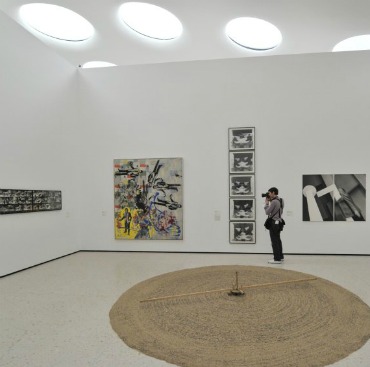 In the last few days, the Städel Museum in Frankfurt has opened its doors on an expansion that’s significant for a couple of reasons.Â
In the last few days, the Städel Museum in Frankfurt has opened its doors on an expansion that’s significant for a couple of reasons.Â
First, the art: The Städel has long been known for its great collection of Old Masters. Now, with the completion of new galleries designed by the architectural firm schneider+schumacher (of Frankfurt), it is showing Western art of the past 700 years. The new space, almost 32,300 square feet, doubles the area available to show the Städel’s holdings. Although the museum has collected some contemporary art in the past, two recent acquisitions – 600 works from the Deutsche Bank collection and 220 photographs from that of the DZ Bank — plus many major donations and some purchases have added what the museum says is 1,200 new contemporary works to the Städel’s collections. About 330 works are on view in the current hanging.
Second, the locale: these new galleries are all located underground, beneath the museum’s garden. They’re invisible from the outside, yet they still soar more than 26 feet in some places, allowing the presentation of big works. The ceiling is supported by juts 12 columns, and the galleries are lit naturally by 195 round skylights, each nearly 5 feet to about 8 feet in diameter, that form a distinctive pattern in the garden. Not that many museums have pulled off such a feat — most just enlarge their footprint, which is not necessarily a good thing. The grassy garden remains pretty much in tact.
Third, the cost: how did the Stadel manage to build these galleries and renovate its old building for less than $72 million at today’s exchange rate? I couldn’t find an exact comparion, but that sounds low to me — especially because the construction was underground.
 Finally, the funding: 50% of that total came from foundations, corporations and individuals. The rest came from the city and the state. Private largesse may be traditional in the U.S. but it’s new to Frankfurt, new to much of Europe. It shows that, whether people like it or not, government support for the arts in Europe is not going to be enough in the future. The museums I speak with in Europe are all talking about emulating the U.S. model, which has its own problems. Â
Finally, the funding: 50% of that total came from foundations, corporations and individuals. The rest came from the city and the state. Private largesse may be traditional in the U.S. but it’s new to Frankfurt, new to much of Europe. It shows that, whether people like it or not, government support for the arts in Europe is not going to be enough in the future. The museums I speak with in Europe are all talking about emulating the U.S. model, which has its own problems. Â
But Max Hollein, the Städel’s director, has worked in the U.S., at the Guggenheim, and he’s said he learned how to raise money here. “One shouldn’t take a ‘no’ as a ‘no,'” he told Der Spiegel. “Rather, it is a sign that the question has merely been formulated wrong.” That article continues:
In Frankfurt, the bankers and collectors like this attitude, even if they insist that the art culture in Germany is very different from the US. But the mindset comes across when they refer to the museum as a “good product” — a comment that many German art lovers would find profoundly profane.
One collector sent Hollein, who had been persistent in his requests, a postcard with a picture of a vulture on it. Nevertheless, she donated four important paintings. The approach clearly works here in Frankfurt, even if it would be unthinkable in other, similarly wealthy German cities such as Hamburg.
I commend the rest of that article to you, if you’re at all interested in Hollein’s thinking. Â
Hollein visited with me in New York when he was here last year, and explained some of the legal questions/arrangements that had to be settled before various donations were accepted. Good for him for working things out. And he’s not shy about gimmicks either — selling yellow rain boots to supporters of the museum, who wear their support in public, for example. (He’s shown in some photos wearing the yellow boots.) So while this transition isn’t always easy, above and beyond asking people for money, it’s done.
And by the accounts I’ve read so far, it’s a job well done.
Here’s a link the the museum’s press releases on the expansion, which are full of more details.
Photo Credits: Courtesy of Der Spiegel
